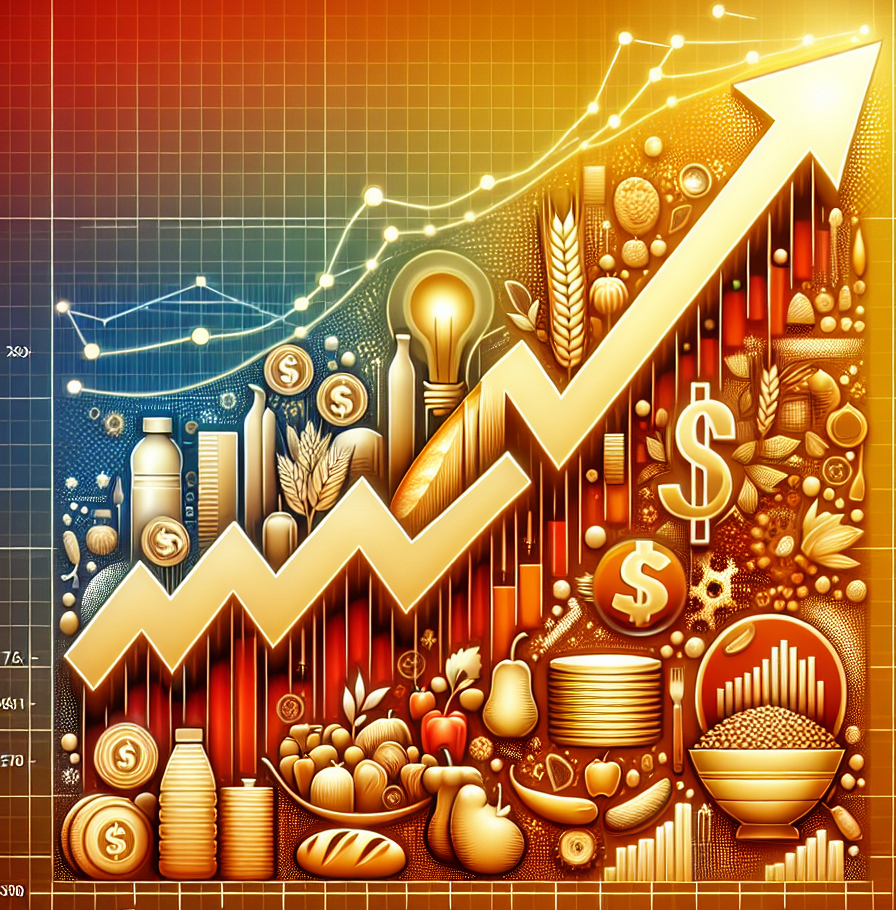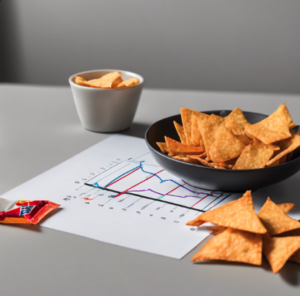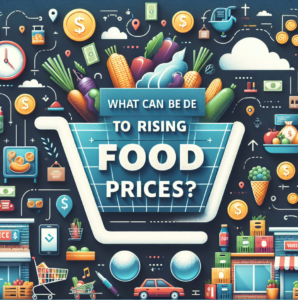
In recent months, there has been a noticeable uptick in the Producer Price Index (PPI), primarily driven by a sharp rise in food prices. The PPI, a key economic indicator, tracks the average change in the selling prices received by domestic producers for their goods and services over time. When the PPI increases, it signifies that the cost of producing goods is on the rise, often due to higher input costs such as materials, labor, and energy.
The latest data indicates that food prices have been a significant factor in this increase. This article will explore the primary reasons behind the surge in food prices, the effect this has on the PPI, and the subsequent ripple effects across both the economy and households. By understanding the causes, the impact, and potential solutions, we aim to offer a comprehensive analysis of this economic shift.
What is the Producer Price Index (PPI)?
The Producer Price Index (PPI) is a measure used to track the average change in the prices received by domestic producers for their goods and services over time. Unlike the Consumer Price Index (CPI), which measures the prices paid by consumers for goods and services, the PPI provides insight into the prices at the producer level.
A rising PPI signals that businesses are facing higher production costs, and these increased costs may eventually trickle down to consumers through higher prices for goods and services. By tracking the PPI, economists and policymakers can gauge inflationary pressures before they reach consumers. The PPI covers a wide range of sectors, including agriculture, manufacturing, mining, and construction, but the latest surge has been notably driven by food prices.
Why Are Food Prices Rising?
Food price increases are not a new phenomenon, but recent spikes have been more pronounced due to a combination of factors that have disrupted the food production and distribution systems. Several key elements contribute to the rising food prices, including supply chain disruptions, extreme weather conditions, labor shortages, and higher energy costs.
1. Supply Chain Disruptions
One of the most significant contributors to rising food prices in 2024 is the ongoing supply chain disruptions that have plagued the global economy since the onset of the COVID-19 pandemic. Even as global trade has recovered, issues such as delays in transportation, lack of shipping containers, and port congestion continue to impact the movement of goods. Perishable food items, such as fresh fruits and vegetables, meat, and dairy products, are particularly vulnerable to these disruptions. These delays not only affect food availability but also increase the costs of transportation and storage, which are eventually passed on to consumers in the form of higher prices.
2. Labor Shortages
The agricultural and food production sectors are also experiencing a significant shortage of labor. Many farmworkers, truck drivers, and processing plant employees have retired, left the workforce, or are unwilling to work under current conditions. The scarcity of labor has forced food producers to raise wages to attract and retain workers. While higher wages are beneficial for workers, they lead to higher production costs, which are inevitably passed on to consumers. Additionally, the labor shortages at processing plants have created bottlenecks, slowing down production and exacerbating the supply-demand imbalance.
3. Extreme Weather Events
Extreme weather conditions have also played a major role in driving up food prices in 2024. Droughts, floods, and storms have severely impacted crop yields, particularly in regions that rely heavily on agriculture. For example, the U.S. Midwest, a critical region for corn and wheat production, has faced drought conditions that reduced yields in 2024. Similarly, floods in parts of Asia have destroyed rice crops, driving up global rice prices. These natural disasters reduce the overall supply of food, which increases scarcity and drives up prices for essential commodities.
4. Higher Energy Prices
Energy costs have surged globally, particularly with rising fuel and natural gas prices. These increased energy prices affect virtually every stage of food production, from growing and harvesting to processing and transportation. Farmers rely on fuel for machinery, while food manufacturers use energy for processing and refrigeration. As these energy costs rise, so does the price of food. For instance, the cost of transporting food by truck has increased substantially due to higher fuel prices, and the added cost is passed on to consumers.
5. Rising Agricultural Input Costs
Another contributing factor to the rise in food prices is the increase in the cost of agricultural inputs. Fertilizers, pesticides, seeds, and machinery—all essential to modern farming—have become significantly more expensive. The surge in the prices of fertilizers, driven by higher natural gas costs and supply chain issues, has been particularly impactful. Farmers are now spending more on the inputs necessary to grow crops, and these costs are inevitably passed on to consumers in the form of higher prices for food items such as grains, vegetables, and meats.
The Impact of Rising Food Prices on the PPI
Food production is a critical component of the Producer Price Index, and the sharp rise in food prices has significantly contributed to the recent increase in the PPI. According to recent data, the food-related sectors—especially meat, poultry, dairy, grains, and vegetables—have experienced the largest price hikes.
1. Meat and Poultry
The price of meat products has surged significantly in 2024, driven by rising feed costs, labor shortages, and supply chain bottlenecks. For example, the price of beef has seen a substantial increase due to higher feed prices and the reduced availability of labor in slaughterhouses. These higher production costs have led to higher retail prices, impacting consumers’ grocery bills.
2. Grains
Grains, such as wheat, corn, and rice, have also experienced significant price hikes. The rise in grain prices has been driven by both extreme weather events and the rising cost of agricultural inputs. Drought conditions in key grain-producing regions, such as the U.S. Midwest, have reduced supply, while the higher cost of fertilizers and other agricultural inputs has pushed production costs higher. These increased costs for producers ultimately result in higher prices at the consumer level.
3. Dairy Products
Dairy prices have also been affected by rising feed and labor costs. The increased cost of producing milk has led to higher prices for dairy products such as cheese, butter, and milk itself. The dairy industry has been facing challenges related to labor shortages, particularly in milk processing plants, where workers are in high demand. As with other food sectors, higher production costs have led to increased prices at the grocery store.
4. Fruits and Vegetables
The cost of fruits and vegetables has risen due to both supply chain disruptions and the rising cost of labor. Extreme weather conditions, such as droughts and floods, have affected crop yields, reducing supply and driving up prices. Additionally, transportation costs have increased due to higher fuel prices, further contributing to rising food prices. The price of staples such as tomatoes, potatoes, and lettuce has been particularly affected by these disruptions.
Implications for Consumers and Businesses
The rise in food prices and the corresponding increase in the Producer Price Index have significant implications for both consumers and businesses.
1. Impact on Consumers
For consumers, the most immediate effect of rising food prices is seen in their grocery bills. As food prices rise, families must allocate more of their budgets to essential goods. For households with limited incomes, this can create significant financial strain, especially as other living costs such as rent, utilities, and healthcare are also rising. In particular, those who rely on staple items like bread, milk, and meat will feel the pinch most acutely.
As food prices increase, there is also the potential for social inequality to worsen. Low-income households are more vulnerable to rising food prices because they spend a larger proportion of their income on food. As prices climb, these households may struggle to maintain a healthy and balanced diet, which could lead to increased levels of food insecurity.
2. Impact on Businesses
For businesses, particularly those in the foodservice and retail sectors, the rise in food prices can have both immediate and long-term effects. Food producers and retailers face higher costs for sourcing and stocking products, which can erode profit margins. Some businesses may be able to absorb these costs for a period, but eventually, they may be forced to pass on the higher costs to consumers, potentially reducing demand.
For restaurants, higher food costs can lead to menu price hikes. Consumers may be less willing to dine out if the price of their meal increases significantly. Similarly, food retailers may need to adjust prices or reduce the number of products offered in order to maintain profitability.
3. Broader Economic Implications
The rise in the Producer Price Index (PPI) due to food prices has broader economic implications. As production costs rise, businesses may seek to offset these costs through automation or other efficiency measures, leading to job displacement in some sectors. Additionally, higher costs at the producer level could lead to broader inflationary pressures, which may prompt central banks to raise interest rates to control inflation.
What Can Be Done to Mitigate Rising Food Prices?
While many factors driving the increase in food prices are beyond the control of consumers and businesses, there are steps that can be taken to mitigate the impact.
1. Improve Supply Chain Efficiency
One way to address rising food prices is to improve the efficiency of the supply chain. For example, optimizing transportation routes, investing in infrastructure, and reducing logistical bottlenecks can help to lower costs for producers and, in turn, consumers.
2. Government Intervention
Governments can also play a role in stabilizing food prices through direct interventions. This might include providing subsidies to farmers, particularly those affected by extreme weather events or rising input costs. Additionally, price controls or tax relief for certain food products could help to reduce the financial burden on consumers.
3. Increase Domestic Production
Encouraging increased domestic food production can help to reduce reliance on global supply chains, which are often vulnerable to disruptions. By supporting local agriculture, governments can help ensure a more stable food supply and reduce the impact of global price fluctuations.
4. Consumer Awareness
Consumers can also play a role in mitigating the impact of rising food prices. Being mindful of food waste, purchasing in bulk, and selecting more affordable alternatives can help to reduce household spending. Supporting local producers and buying seasonal produce can also help to lower costs and ensure fresher food.
The rise in food prices has had a significant impact on the Producer Price Index in 2024, and this trend is expected to continue as various factors—including supply chain disruptions, extreme weather events, labor shortages, and rising energy costs—continue to influence food production. While the consequences are felt across the economy, from households to businesses, understanding the causes behind these price hikes can help consumers and businesses make informed decisions.
As we move forward, it’s clear that a combination of improving supply chain efficiency, government intervention, and consumer awareness will be essential to mitigating the effects of rising food prices. While the situation may be challenging, understanding the underlying causes and taking proactive measures will help to minimize the impact of this economic shift.
Feel free to check out our other website at : https://synergypublish.com



